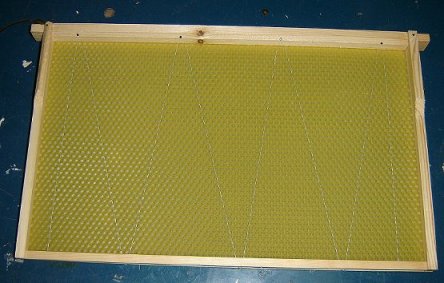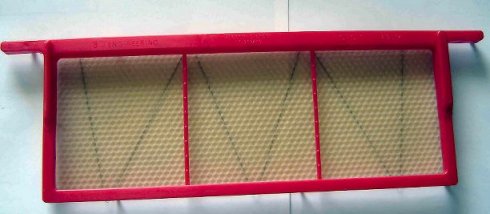Back to the Beepedia Index...
Beekeeping Techniques

Apiaries require an ample supply of nectar and pollen and are
usually kept where nectar-producing plants such as clover or eucalyptus are
abundant. Some beekeepers transport their bees to suitable foraging ground,
these are known as migratory apiaries. Apiaries may consist of 1 to 200
hives, depending on the means of the beekeeper and the flower resources
available.
Commercial beekeepers that make their entire living from bees often
keep hundreds or thousands of hives. Keepers also abide by the three rule, this
is a theory that most keepers stick to - do not move the hive more than three
feet (1 metre) in one move, but you can move it more than three miles (5 kilometres). This is because
the bee forages to a distance of three miles but if the hive has been moved
more than three feet they get disorientated and cannot locate the hive. Move
the hive either small distances at a time in the apiary or to
re-locate you must move it more than three miles, away from familiar ground.
Re-open once re-located and settled.
In the UK beekeepers have standardized their
equipment, using boxes (called supers) that hold eleven wood-bound comb frames.
The brood box where the Queen lays and the young bees are reared is the nest of
the hive, this box often holds eleven wooden-bound comb frames and is larger
than the supers. The brood box goes at the bottom with the supers above, these
are in place to collect the surplus honey, which is harvested by the beekeeper.
A grill called the Queen excluder is placed between the brood and first super
box in order to keep the Queen and drones out of the supers, this prevents the
Queen laying in the combs in the super and the drones eating the supplies. All
that is stored in the supers can be harvested because it is all honey. The supers
can be filled up rapidly during a good honey producing season and can be removed
from the hive around August at the end of the season.

The typical components of a beehive
There are some modern alternatives to the
wooden hives, which vary in style and size. You can obtain polystyrene hives, plastic frames
and other equipment made from various modern materials.Some hive designs include: WBC, British
National, Smith, Langstroth, Dadant and commercial.
These can be used with a variety of frames
and foundation. Frames can be wooden or plastic and they hold the wax
foundation which is drawn out by the bees for storage of honey, pollen and
brood. These are suspended inside the hive with a bee space and this provides the
bees the opportunity to move around and use the hive like a natural home but also
provides the beekeeper with a form of management control.
Good husbandry and hygiene is very important
in order to maintain a healthy hive. Advantages of wooden hives are that you
can scorch the inside to sterilize them, whilst plastic can be cleaned with hot
water and disinfectants. Both methods help to provide a hygienic, clean environment
for the bees to live in.

A wooden frame
Above is a picture of a Wired Wax Foundation supported in a wooden
brood frame. The wire helps to support the wax as when full with honey or
brood it can weigh several kilograms and could fall out of the frame during
inspection.

A plastic frame
Above is a picture of a Wired foundation in a plastic super frame,
this frame has centre supports that can hold unwired foundation. Plastic frames last for
years and can be cleaned easily with hot water.
Honeybees are adaptable insects that can survive under a variety of situations
and conditions. However, insecticides kill and weaken thousands of
colonies each year. Beekeepers who rent their colonies for pollination also
expect some loss of bees that drink from contaminated pools. Honey itself is
generally free from insecticides, because when a food source becomes
contaminated, the colony is killed or weakened, and so the bees cannot produce
a surplus for harvest. Other problems facing beekeepers include loss of forage
due to habitat destruction by humans, parasitic mites, bacterial, fungal, and
viral diseases.
Honey is a natural sweetener and source of
carbohydrates. Honey is believed to have health giving properties and has been
proved to have a healing effect on open wounds. It draws moisture from the
wound, which protects from further infection, and also has antiseptic properties that
destroy local infection. Please see our health benefits section for further details.
Back to the Beepedia Index...
|